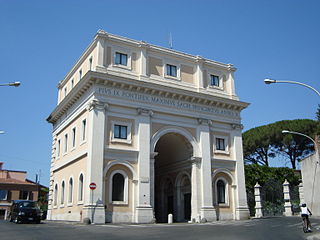
Porta San Pancrazio is one of the southern gates of the Aurelian walls in Rome, Italy.

Milano Porta Garibaldi is a major railway station in the Italian city of Milan, located just to the north of the neighbourhood known as Porta Garibaldi. Porta Garibaldi is the city's main station for commuter traffic with 25 million passengers annually, although it is second to Centrale station considering total passenger traffic. The station is located on Piazza Sigmund Freud.

Porta Nuova is one of the main business districts of Milan, Italy in terms of economy, and part of the Zone 2 administrative division. Named after the well-preserved Neoclassic gate built in 1810 on this site, it is now one of Italy's most high-tech and international districts, containing the country's tallest skyscraper: the Unicredit Tower.
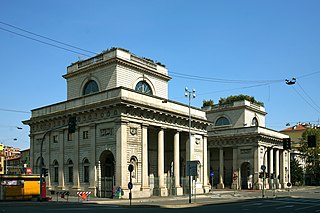
Porta Venezia is one of the historical gates of the city of Milan, Italy. In its present form, the gate dates back to the 19th century; nevertheless, its origins can be traced back to the medieval and even the Roman walls of the city.

Porta Vittoria was a city gate in the Spanish walls of Milan, Italy. While the walls and the gate have been demolished, the name "Porta Vittoria" has remained to refer to the district ("quartiere") where the gate used to be. This district is part of the Zone 4 administrative division of Milan.

Porta Romana is a former city gate of Milan, Italy. In its present form, the gate dates back to the 16th century Spanish walls of Milan. Its origins can be traced further back to the Roman walls of the city, which had a corresponding "Roman Gate" roughly in the same area. Porta Romana was the first and the main imperial entrance of the entire city of Milan, as it was the starting point of the road leading to Ancient Rome. According to a survey conducted by Scenari Immobiliari in 2020, this area is in first place in the ranking of the neighborhoods that offer the best liveability in Milan.
Porta Vigentina was one of the city gates in the Spanish walls of Milan, Italy; the gate has since been demolished, but the phrase "Porta Vigentina" is still used to refer to the district ("quartiere") where the gate used to be. The area is part of the Zone 5 administrative division of Milan.
Porta Lodovica was a city gate of the Spanish walls of Milan, Italy, named after Ludovico Sforza. According to a survey conducted by Scenari Immobiliari in 2020, this area is in first place in the ranking of the neighborhoods that offer the best liveability in Milan.
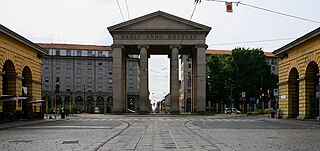
Porta Ticinese is a former city gate of Milan, Italy. The gate, facing south-west, was first created with the Spanish walls of the city, in the 16th century, but the original structure was later demolished and replaced in the early 19th century. The name "Porta Ticinese" is used both to refer to the gate proper and to the surrounding district, part of the Zone 6 administrative division. In the same district there is also a medieval gate with the same name, although in common speech the name "Porta Ticinese" is usually assumed to refer to the 19th century gate.

Porta Magenta, formerly known as Porta Vercellina, was one of the city gates of Milan, Italy. The gate was established in the 9th century, with the Roman walls of the city; it was moved with the medieval and Spanish walls, and was finally demolished in the 19th century. The phrase "Porta Magenta" is now used to refer to the district ("quartiere") where the gate used to be; the district is part of the Zone 7 administrative division of Milan, west of the city centre.

Porta Volta is a former city gate of Milan, Italy, part of the Spanish walls. Nowadays, the name "Porta Volta" is most commonly used to refer to the surrounding district ("quartiere"), part of the Zone 8 administrative division of the city.

Porta Garibaldi is part of Milan's ancient wall and gate system, built along the now demolished Spanish ramparts, also part of Milan's wall system. Located north of the city, it opens along the ancient road to Como. Characterized by the presence of a neoclassical arch built by Moraglia and the adjoining toll booths, it stands in the center of Piazza XXV Aprile, at the mouth of the street Corso Garibaldi.
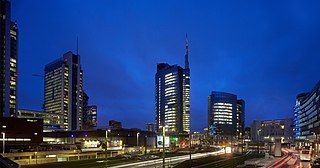
The Centro Direzionale di Milano is a business district (quartiere) in Milan, Italy, part of the Zone 9 administrative division. It is located north-west of the city centre, between the major railway stations of Milano Centrale and Milano Porta Garibaldi. The district developed in the second half of the 20th century; its realization was planned by the city administration to relieve congestion in the city centre by moving business and tertiary activities in the new area. Coherently with this plan, the district is mainly occupied by modern office buildings, including several of Milan's skyscrapers.

Como San Giovanni railway station is the main station serving the city and comune of Como, in the region of Lombardy, northern Italy. Opened in 1875, it forms part of the Milan–Chiasso railway, and is also a terminus of the Como–Lecco railway, which branches off the main line a few kilometres (miles) to the south, at Albate-Camerlata.

The Zone 1 of Milan, since 2016 officially Municipality 1 of Milan, is one of the 9 administrative divisions of Milan, Italy.

Viale Pasubio is an avenue in Milan, Italy. It is part of the circonvallazione interna ring road, a major traffic route that runs along the former Spanish walls of Milan. The street is 350 m long and connects two former city gates, namely Porta Garibaldi and Porta Volta. The street was formerly known as "Viale di Porta Garibaldi", and was renamed after World War I in remembrance of the fightings on the Pasubio massif (Dolomites) that occurred during the war.

The Zone 3 of Milan, since 2016 officially Municipality 3 of Milan, is one of the 9 administrative divisions of Milan, Italy.
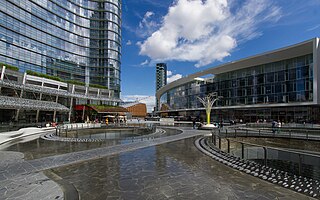
The Zone 9 of Milan, since 2016 officially Municipality 9 of Milan, is one of the 9 administrative divisions of Milan, Italy.

The S11 is a commuter rail route forming part of the Milan suburban railway service, which converges on the city of Milan, Italy.

Porta Torre is a main fortified tower located in the town of Como, in Lombardy. It is 40 meters high and it was built in 1192, to defend the main entrance of the city.


















